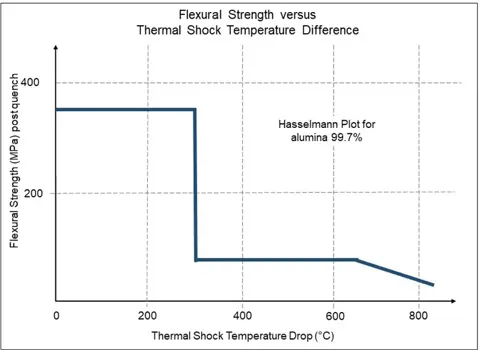Technical Ceramics

Thermal Shock Resistance
The ability of a material to withstand a rapid and significant change in temperature is represented by its thermal shock resistance (Rs).
Contact usWhen a ceramic is cooled rapidly, the exterior surface temperature of the ceramic drops more quickly than the interior portion of the ceramic. This thermal gradient causes tensile stress to form on the ceramic surface because the cooler surface wants to contract but the contraction is resisted by the warmer interior portion of the ceramic. Due to the brittle nature of the ceramic, this tensile stress may cause cracks to form on the surface of the part.
Ceramic Thermal Shock Resistance
Some ceramics, such as fused silica and cordierites, have notably superior thermal shock performance when compared to other ceramics. Fused silica (synthetic quartz or silicon oxide, SiO2), cordierite, and silicon nitrides (Si3N4) have very low coefficients of thermal expansion; therefore, their thermal shock resistance is relatively high.
Factors such as the material’s fracture toughness, specific heat capacity, porosity, and the part’s geometry will also affect the material’s thermal shock resistance. For example, zirconia toughened alumina (ZTA) is known for its thermal shock resistance due to its high fracture toughness.
| Ceramic | Thermal Downshock Resistance (delta °C) |
| Silicon Nitride | 900 |
| Zirconia | 400-500 |
| Silicon Carbide | 400 |
| Alumina | 170-300 |
Hasselmann Method
A test method, known as the Hasselmann Method, can be used to measure a ceramic material’s sensitivity to thermal shock. In this test, flexural test coupons are heated to various temperatures before being quenched in a cooled fluid. The flexural strengths of the quenched coupons are then subsequently measured in bending tests. The flexural strengths of the samples are then plotted versus the temperature drops experienced by each of the quenched coupons. The temperature delta where the coupons experience a dramatic drop of flexural strength becomes the parameter which indicates the material's thermal shock resistance contrasted to other candidate materials. The below chart illustrates an example plot.

Melting Temperature
Ceramics have very high melting points, typically exceeding 2000°C, higher than plastics and many metals. This makes ceramic particularly useful in metal foundry applications, cores for castings, kiln furniture, and thermocouple protection tubes.



